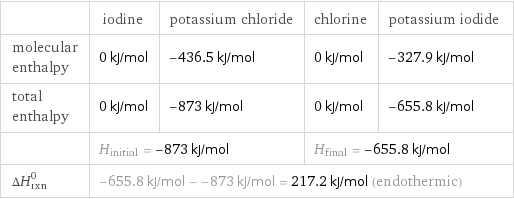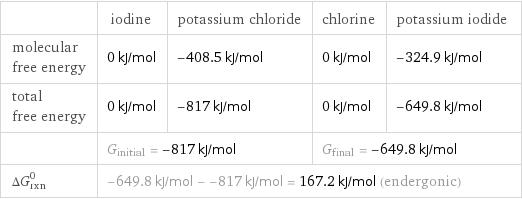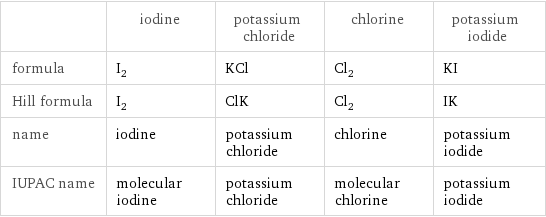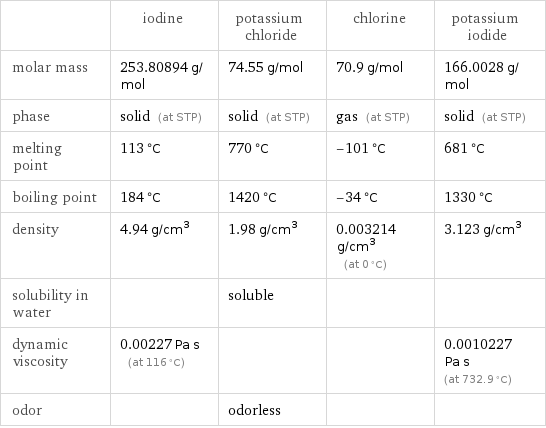Input interpretation

I_2 iodine + KCl potassium chloride ⟶ Cl_2 chlorine + KI potassium iodide
Balanced equation

Balance the chemical equation algebraically: I_2 + KCl ⟶ Cl_2 + KI Add stoichiometric coefficients, c_i, to the reactants and products: c_1 I_2 + c_2 KCl ⟶ c_3 Cl_2 + c_4 KI Set the number of atoms in the reactants equal to the number of atoms in the products for I, Cl and K: I: | 2 c_1 = c_4 Cl: | c_2 = 2 c_3 K: | c_2 = c_4 Since the coefficients are relative quantities and underdetermined, choose a coefficient to set arbitrarily. To keep the coefficients small, the arbitrary value is ordinarily one. For instance, set c_1 = 1 and solve the system of equations for the remaining coefficients: c_1 = 1 c_2 = 2 c_3 = 1 c_4 = 2 Substitute the coefficients into the chemical reaction to obtain the balanced equation: Answer: | | I_2 + 2 KCl ⟶ Cl_2 + 2 KI
Structures

+ ⟶ +
Names

iodine + potassium chloride ⟶ chlorine + potassium iodide
Reaction thermodynamics
Enthalpy

| iodine | potassium chloride | chlorine | potassium iodide molecular enthalpy | 0 kJ/mol | -436.5 kJ/mol | 0 kJ/mol | -327.9 kJ/mol total enthalpy | 0 kJ/mol | -873 kJ/mol | 0 kJ/mol | -655.8 kJ/mol | H_initial = -873 kJ/mol | | H_final = -655.8 kJ/mol | ΔH_rxn^0 | -655.8 kJ/mol - -873 kJ/mol = 217.2 kJ/mol (endothermic) | | |
Gibbs free energy

| iodine | potassium chloride | chlorine | potassium iodide molecular free energy | 0 kJ/mol | -408.5 kJ/mol | 0 kJ/mol | -324.9 kJ/mol total free energy | 0 kJ/mol | -817 kJ/mol | 0 kJ/mol | -649.8 kJ/mol | G_initial = -817 kJ/mol | | G_final = -649.8 kJ/mol | ΔG_rxn^0 | -649.8 kJ/mol - -817 kJ/mol = 167.2 kJ/mol (endergonic) | | |
Equilibrium constant
![Construct the equilibrium constant, K, expression for: I_2 + KCl ⟶ Cl_2 + KI Plan: • Balance the chemical equation. • Determine the stoichiometric numbers. • Assemble the activity expression for each chemical species. • Use the activity expressions to build the equilibrium constant expression. Write the balanced chemical equation: I_2 + 2 KCl ⟶ Cl_2 + 2 KI Assign stoichiometric numbers, ν_i, using the stoichiometric coefficients, c_i, from the balanced chemical equation in the following manner: ν_i = -c_i for reactants and ν_i = c_i for products: chemical species | c_i | ν_i I_2 | 1 | -1 KCl | 2 | -2 Cl_2 | 1 | 1 KI | 2 | 2 Assemble the activity expressions accounting for the state of matter and ν_i: chemical species | c_i | ν_i | activity expression I_2 | 1 | -1 | ([I2])^(-1) KCl | 2 | -2 | ([KCl])^(-2) Cl_2 | 1 | 1 | [Cl2] KI | 2 | 2 | ([KI])^2 The equilibrium constant symbol in the concentration basis is: K_c Mulitply the activity expressions to arrive at the K_c expression: Answer: | | K_c = ([I2])^(-1) ([KCl])^(-2) [Cl2] ([KI])^2 = ([Cl2] ([KI])^2)/([I2] ([KCl])^2)](../image_source/f95c66e770eafbfdef4af590d58767ba.png)
Construct the equilibrium constant, K, expression for: I_2 + KCl ⟶ Cl_2 + KI Plan: • Balance the chemical equation. • Determine the stoichiometric numbers. • Assemble the activity expression for each chemical species. • Use the activity expressions to build the equilibrium constant expression. Write the balanced chemical equation: I_2 + 2 KCl ⟶ Cl_2 + 2 KI Assign stoichiometric numbers, ν_i, using the stoichiometric coefficients, c_i, from the balanced chemical equation in the following manner: ν_i = -c_i for reactants and ν_i = c_i for products: chemical species | c_i | ν_i I_2 | 1 | -1 KCl | 2 | -2 Cl_2 | 1 | 1 KI | 2 | 2 Assemble the activity expressions accounting for the state of matter and ν_i: chemical species | c_i | ν_i | activity expression I_2 | 1 | -1 | ([I2])^(-1) KCl | 2 | -2 | ([KCl])^(-2) Cl_2 | 1 | 1 | [Cl2] KI | 2 | 2 | ([KI])^2 The equilibrium constant symbol in the concentration basis is: K_c Mulitply the activity expressions to arrive at the K_c expression: Answer: | | K_c = ([I2])^(-1) ([KCl])^(-2) [Cl2] ([KI])^2 = ([Cl2] ([KI])^2)/([I2] ([KCl])^2)
Rate of reaction
![Construct the rate of reaction expression for: I_2 + KCl ⟶ Cl_2 + KI Plan: • Balance the chemical equation. • Determine the stoichiometric numbers. • Assemble the rate term for each chemical species. • Write the rate of reaction expression. Write the balanced chemical equation: I_2 + 2 KCl ⟶ Cl_2 + 2 KI Assign stoichiometric numbers, ν_i, using the stoichiometric coefficients, c_i, from the balanced chemical equation in the following manner: ν_i = -c_i for reactants and ν_i = c_i for products: chemical species | c_i | ν_i I_2 | 1 | -1 KCl | 2 | -2 Cl_2 | 1 | 1 KI | 2 | 2 The rate term for each chemical species, B_i, is 1/ν_i(Δ[B_i])/(Δt) where [B_i] is the amount concentration and t is time: chemical species | c_i | ν_i | rate term I_2 | 1 | -1 | -(Δ[I2])/(Δt) KCl | 2 | -2 | -1/2 (Δ[KCl])/(Δt) Cl_2 | 1 | 1 | (Δ[Cl2])/(Δt) KI | 2 | 2 | 1/2 (Δ[KI])/(Δt) (for infinitesimal rate of change, replace Δ with d) Set the rate terms equal to each other to arrive at the rate expression: Answer: | | rate = -(Δ[I2])/(Δt) = -1/2 (Δ[KCl])/(Δt) = (Δ[Cl2])/(Δt) = 1/2 (Δ[KI])/(Δt) (assuming constant volume and no accumulation of intermediates or side products)](../image_source/ee442bd9a1bcf8d80d93d7c0d7af6426.png)
Construct the rate of reaction expression for: I_2 + KCl ⟶ Cl_2 + KI Plan: • Balance the chemical equation. • Determine the stoichiometric numbers. • Assemble the rate term for each chemical species. • Write the rate of reaction expression. Write the balanced chemical equation: I_2 + 2 KCl ⟶ Cl_2 + 2 KI Assign stoichiometric numbers, ν_i, using the stoichiometric coefficients, c_i, from the balanced chemical equation in the following manner: ν_i = -c_i for reactants and ν_i = c_i for products: chemical species | c_i | ν_i I_2 | 1 | -1 KCl | 2 | -2 Cl_2 | 1 | 1 KI | 2 | 2 The rate term for each chemical species, B_i, is 1/ν_i(Δ[B_i])/(Δt) where [B_i] is the amount concentration and t is time: chemical species | c_i | ν_i | rate term I_2 | 1 | -1 | -(Δ[I2])/(Δt) KCl | 2 | -2 | -1/2 (Δ[KCl])/(Δt) Cl_2 | 1 | 1 | (Δ[Cl2])/(Δt) KI | 2 | 2 | 1/2 (Δ[KI])/(Δt) (for infinitesimal rate of change, replace Δ with d) Set the rate terms equal to each other to arrive at the rate expression: Answer: | | rate = -(Δ[I2])/(Δt) = -1/2 (Δ[KCl])/(Δt) = (Δ[Cl2])/(Δt) = 1/2 (Δ[KI])/(Δt) (assuming constant volume and no accumulation of intermediates or side products)
Chemical names and formulas

| iodine | potassium chloride | chlorine | potassium iodide formula | I_2 | KCl | Cl_2 | KI Hill formula | I_2 | ClK | Cl_2 | IK name | iodine | potassium chloride | chlorine | potassium iodide IUPAC name | molecular iodine | potassium chloride | molecular chlorine | potassium iodide
Substance properties

| iodine | potassium chloride | chlorine | potassium iodide molar mass | 253.80894 g/mol | 74.55 g/mol | 70.9 g/mol | 166.0028 g/mol phase | solid (at STP) | solid (at STP) | gas (at STP) | solid (at STP) melting point | 113 °C | 770 °C | -101 °C | 681 °C boiling point | 184 °C | 1420 °C | -34 °C | 1330 °C density | 4.94 g/cm^3 | 1.98 g/cm^3 | 0.003214 g/cm^3 (at 0 °C) | 3.123 g/cm^3 solubility in water | | soluble | | dynamic viscosity | 0.00227 Pa s (at 116 °C) | | | 0.0010227 Pa s (at 732.9 °C) odor | | odorless | |
Units
